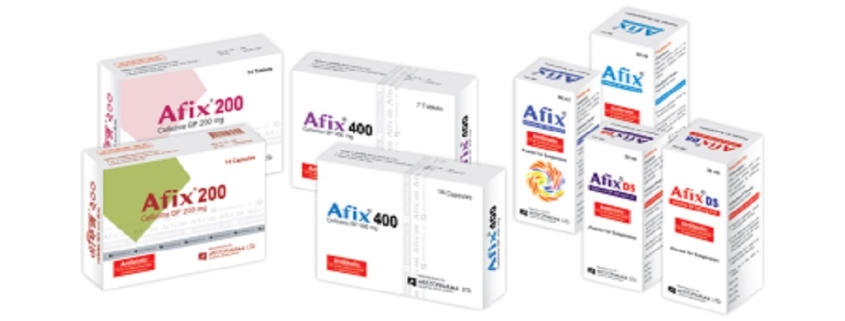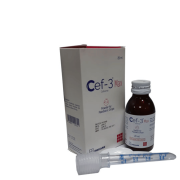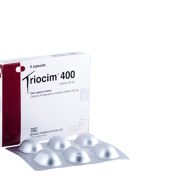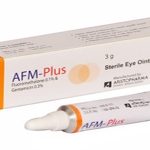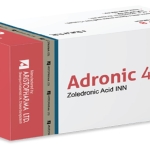Afix (Cefixime)
Afix (Cefixime) is a broad spectrum 3rd generation cephalosporin antibiotic for oral administration.
Description
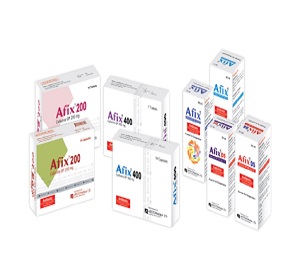
Afix® (Cefixime) is a broad spectrum 3rd generation cephalosporin antibiotic for oral administration. It is a bactericidal antibiotic and is stable to hydrolysis by many beta-lactamases. Cefixime kills bacteria by interfering the synthesis of the bacterial cell wall. It is highly active against Neisseria gonorrhoeae, Haemophilus influenzae, Moraxella catarrhalis including beta-lactamase producers, most of the Enterobacteriaceae, beta-haemolytic Streptococci (Group A & B) and Streptococcus pneumoniae. It is more active than other oral cephalosporins against Escherichia coli, Klebsiella spp, Proteus mirabilis and Serratia marcescens. It is also active against Streptococcus pyogenes. 40-50% of an oral dose is absorbed from gastro-intestinal tract, whether taken with meals or not. The plasma half-life is usually about 3 to 4 hours and may be prolonged when there is renal impairment. About 65% is bound to plasma protein. Cefixime is mainly excreted unchanged in bile and urine.
Presentation
Afix® 200 Capsule: Each capsule contains Cefixime Trihydrate BP equivalent to Anhydrous Cefixime 200 mg.
Afix® 400 Capsule: Each capsule contains Cefixime Trihydrate BP equivalent to Anhydrous Cefixime 400 mg.
Afix® 200 Tablet: Each tablet contains Cefixime Trihydrate BP equivalent to Anhydrous Cefixime 200 mg.
Afix® 400 Tablet: Each tablet contains Cefixime Trihydrate BP equivalent to Anhydrous Cefixime 400 mg.
Afix® Powder for Suspension: After preparation, each 5 ml contains Cefixime Trihydrate BP equivalent to Anhydrous Cefixime 100 mg.
Afix® DS Powder for Suspension: After preparation, each 5 ml contains Cefixime Trihydrate BP equivalent to Anhydrous Cefixime 200 mg.
Indications
- Upper respiratory tract infections: Otitis media and other URTI where the causative organism is known or suspected to be resistant to other commonly used antibiotics.
- Lower respiratory tract infection: Bronchitis.
- Urinary tract infections: Cystitis, cystourethritis, pyelonephritis, gonococcal urethritis.
- Gonorrhoea (Uncomplicated).
- Typhoid fever.
Dosage & Administration
The usual course of treatment is 7 days. This may be continued for up to 14 days if required.
Afix® Tablet & Capsule:
Adult & Child over 10 years: 200-400 mg daily 1-2 divided doses.
Gonorrhoea: 400 mg as a single dose.
Afix® Powder for Suspension & DS Powder for Suspension:
Children above 6 months: 8 mg/kg daily in 1-2 divided doses or
6 months-1 year: 75 mg daily
1-4 years: 100 mg daily
5-10 years: 200 mg daily
Typhoid fever: 20 mg/kg body weight daily in 2 divided doses for 10 days
Contrainidications
Cefixime is contraindicated in patients with known hypersensitivity to the cephalosporin antibiotics.
Warning & Precautions
Cephalosporins should be given with caution to penicillin-sensitive patients, as there is some evidence of partial cross-allergenicity between the penicillins and cephalosporins. Cefixime should be administered with caution in patients with markedly impaired renal function. In patients whose creatinine clearance is less than 20 ml/min, it is recommended that a dose of 200 mg once daily should not be exceeded.
Side effects
Afix® is generally well tolerated. The majority of adverse reactions observed in clinical trials were mild and self-limiting in nature.
Gastro-intestinal disturbances: Diarrhoea (if severe diarrhoea occurs, Afix® should be discontinued), changes in the color of stool, nausea, abdominal pain, dyspepsia, vomiting, flatulence have been reported.
Central nervous system disturbances: Headache, dizziness etc.
Others: Hypersensitivity reactions which usually subsided upon discontinuation of therapy; infrequent and reversible haematological changes; elevation of serum amylase etc.
Drug interaction
Carbamazepine: Elevated carbamazepine levels have been reported.
Warfarin and Anticoagulants: Increased prothrombin time with or without clinical bleeding has been reported when cefixime is administered concomitantly.
Use in special groups
Use in Pregnancy:
There are no adequate and well-controlled studies in pregnant women. So this drug should be used during pregnancy only if clearly needed.
Use in Lactation:
It is not known whether cefixime is excreted in human milk. So it is probably best either to avoid using the drug by nursing mother or to discontinue breast feeding.
Use in Children:
Safety and effectiveness of cefixime in children aged less than 6 months have not been established.
Packing
Afix® 200 Capsule: Box containing 12 capsules in Alu-Alu blister pack.
Afix® 400 Capsule: Box containing 14 capsules in Alu-Alu blister pack.
Afix®200 Tablet: Box containing 12 tablets in Alu-Alu blister pack.
Afix® 400 Tablet: Box containing 7 tablets in Alu-Alu blister pack.
Afix® Powder for Suspension: Bottle containing dry powder for preparation of 30/50 ml suspension.
Afix® DS Powder for Suspension: Bottle containing dry powder for preparation of 30/50 ml suspension.

